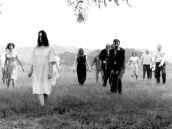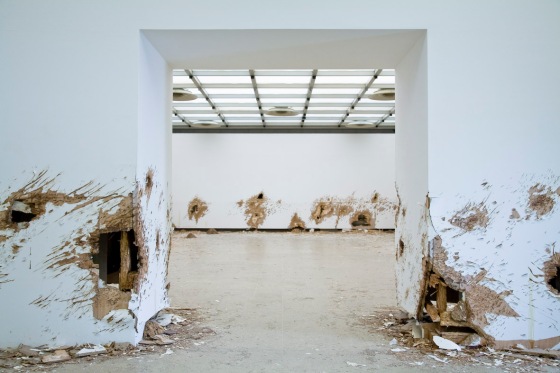“The trumpets of the apocalypse have been sounding at our gates for years now, but we still stop up our ears. We do, however, have four new horsemen: overpopulation (the leader, the one waiving the flag), science, technology, and the media. All the other evils in the world are merely consequences of these. I’m not afraid to put the press in the front rank, either. The last screenplays I worked on, for a film I’ll never make, deal with a triple threat: science, terrorism, and the free press. The last, which is usually seen as a victory, a blessing, a ‘right,’ is perhaps the most pernicious of all, because it feeds on what the three other horsemen leave behind.’ – Luis Bunuel from My Last Sigh (page 251-252)
Horror Vacui – Installation
 Horror vacui: fear of an empty space
Horror vacui: fear of an empty space
Horror vacui is a project for the 2013 Lisbon Architecture Triennale Close, Closer that fills the dreaded emptiness, the void, via a participatory architectural exchange.
The term horror vacui describes a Moorish visual practice adopted by Portuguese builders in the 15th century, which involved covering building facades with azulejos, blue and white tiles commemorating scenes from historic events, in order to overcome the unbearable emptiness of the wall. Today’s architects are faced with a different kind of void that takes the form of a widening abyss between designers, fabricators, and users, all searching for common ground.
Curators: Jaffer Kolb, Ang Li, Phoebe Springstubb
Gallery Goings: from Pettibon to Collins
Brief recap of gallery exhibitions from October 2, 2013.
Aldo Tambellini We Are the Primitives of a New Era at James Cohan Gallery
Blows everything away. Read review here.
Raymond Pettibon To Wit at David Zwirner
Pettibon’s ongoing original narrative on America culture with his interest in language, humor, film noir, baseball, and surfing now includes personal expositions on his family (wife, son, dog).
David Noonan at Foxy Productions
Theatrical in content, David Noonan’s de-sconstructed works usually hold a mythologized quality to them that’s sooky and enchanted. The interest in his new works that appropriate images of Butoh (Japanese experimental theater) lies less in the abstracted imagery and more in the politicized content the group embodies.
Michael Raedecker at Andrea Rosen Gallery
While it may be tempting to discuss this work solely in terms of its formal qualities, it seems far more interesting to discuss the embodiment of suburbian norms through seriality and literal inversion in a nearly post-apocalyptic landscape.
Damian Ortega at Gladstone Gallery
Twenty-five suspended steel objects, each lit by overhead lights, cast shadows of the alphabet. Considered this a spatial call for a new language. STUNNING. (see image)
Phil Collins at Tanya Bodakar Gallery
Installations where the viewer must participate in order to fully comprehend the work aren’t really where my interests lie but Collin’s video The Meaning of Style is a mesmerizing commentary on the appropriation of subcultures (in this case, UK Skinhead culture).
Josh Azzarella at Moving Image Art Fair London 2013
Josh Azzarella is screening his Untitled #160 (Balcome) at the Moving Image Art Fair 2013 London edition this month. Read what I recently wrote about the piece below and, if you’re in London, be sure to not miss it.
…Appropriately, this exhibition coincides with the presentation of a new video work by Josh Azzarella, Untitled #160 (Balcombe), in which he has reconstructed F.W. Murnau’s seminal silent film Nosferatu (1922) by eliminating all (un)human figures. Architecture looms more prominently than before, doors mysteriously function on their own, the gloomy atmosphere spreads more ominously, blank spaces replace title cards. Here, through this mining of culture and our collective reference to it, Azzarella establishes a precise example of what a rendering of a “world without us” or an empty distance can look like. Our relation to the memory of what was there (Meena and Jonathan Harker, Renfield, the Vampire) is entirely dependent upon a successful reading of the new and very different environment. It’s a reconfiguration of a continuously self-reflexive undying narrative of the vampire, specifically the transformative character of Dracula, repeated and recycled and transformed in its literary and cinematic forms. Untitled #160 (Balcombe) constructs a new language of absence through its ghostly presence. Through that we are able to position ourselves in a very strange, yet familiar, landscape; one that does not include us.
Untitled #160 (Balcombe) – Preview from Josh Azzarella on Vimeo.
Girl. Hair. Horror.
Bernard Tschumi – Advertisements for Architecture
You Must Taste Blood to be a Man
Book Review: Horror in Architecture
 I had been eagerly awaiting the publication of Singapore-based architects Joshua Comaroff & Ong Ker-Shing’s new book Horror in Architecture for months as it specifically addresses the two very things I’m currently researching: horror and architecture. The book’s introduction nails a correlation between “horror” and the sublime, an idea that I usually discard because of its cathartic and religious implications but presenting the two as being both unknowable, spectral and inexplicable but extremely palpable is quite convincing. “Horror is the truth about abstraction” is another provocative statement that also rings true when considering how horror “weirds” what is familiar. From there, their discussions of the double, disjunction, repetition, deformation, interior/exterior are certainly of interest if perhaps all too brief.
I had been eagerly awaiting the publication of Singapore-based architects Joshua Comaroff & Ong Ker-Shing’s new book Horror in Architecture for months as it specifically addresses the two very things I’m currently researching: horror and architecture. The book’s introduction nails a correlation between “horror” and the sublime, an idea that I usually discard because of its cathartic and religious implications but presenting the two as being both unknowable, spectral and inexplicable but extremely palpable is quite convincing. “Horror is the truth about abstraction” is another provocative statement that also rings true when considering how horror “weirds” what is familiar. From there, their discussions of the double, disjunction, repetition, deformation, interior/exterior are certainly of interest if perhaps all too brief.
Horror in Architecture seems particularly interested in relating architecture to the monstrous, a valid correlation that loses its poignancy when the authors continuously refer to Mary Shelley’s monster as “Frankenstein” when, in fact, “Frankenstein” is the young mad doctor. Along with the green face, bolts to the neck, and flat head, it’s a pop-culture adaptational norm to call the monster “Frankenstein” but it’s still glaringly incorrect. While I would argue that Dr. Frankenstein is perhaps even more monstrous that the monster he created, it’s hard to overlook this error and to trust further concepts they put forth that I’m unfamiliar with.
Aside from other general editorial issues (wrong words, doubling of words, incorrect spacing), the book really omits the real source of architecture’s horror by offer only a cursory address of economics and capitalism in relation to buildings, culture, and society. Horror very pointedly tackles socio-political issues of its time and, with the immediacy of architecture to the population and the economic context in which houses, businesses, and skyscrapers are built, it would seem fundamental in a discussion about how architecture embraces the horrific. For instance, what could be more horrifying than neglected public housing complexes ala Candyman (Bernard Rose, 1992)? Politics, economics, society – these are all fundamental elements to why horror and architecture exist and, most importantly, what they represent.
What we must take-away from Architectural Horrors is an idea proposed towards the beginning: ”…all present the possibilities of deviant architecture as an opening into new worlds of form, composition, space-making, program and hierarchy.” As scholars, filmmakers, authors, and artists use horror to establish an understanding of the world around us, it therefore seems crucial to consider the relationship between our built environment and horror as a productive site of contemplation and of future possibilities.
Bernard Tschumi – Advertisements for Architecture
Psycho Buildings
“Here, we find architecture not in its functional guise but as a site of desire, memory and doubt, home to personal contingencies and collective histories, the clashing of cultures and coalescing of subjectivities. Refusing to address us in the spaces they generate, engaging us in ways that are at once visceral and conceptual, and that call attention to what must be experienced rather than merely seen.” – Ralph Rugoff, Psycho Buildings from the exhibition Psycho Buildings: Artists Take On Architecture.
Image: Mike Nelson, To the Memory of H.P. Lovecraft (1999), 2008.



















